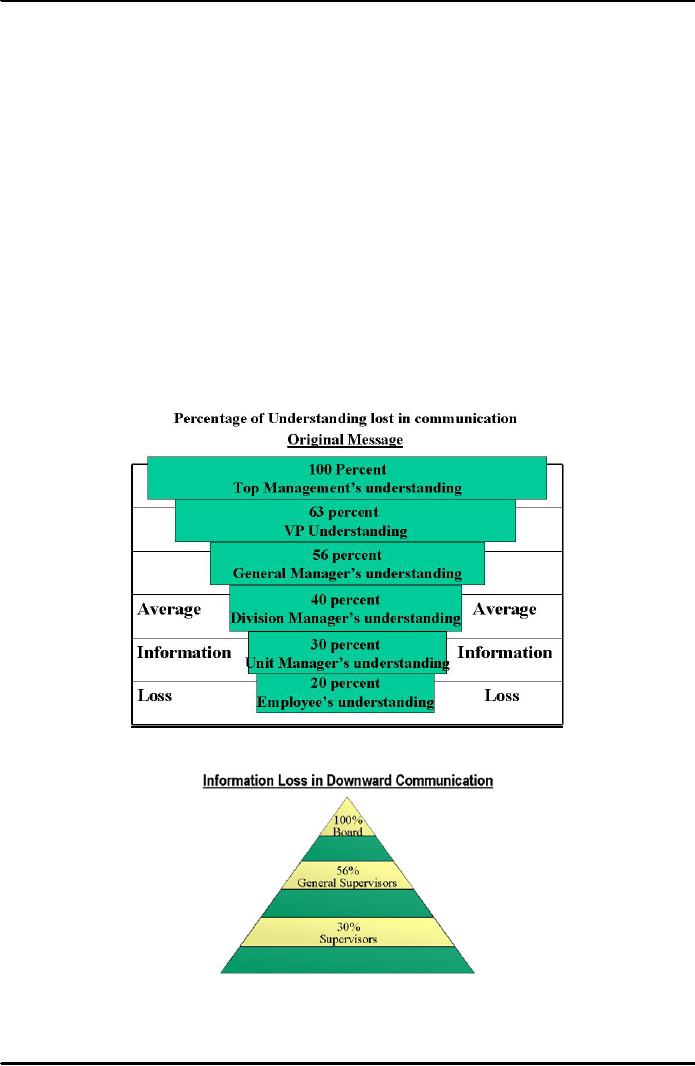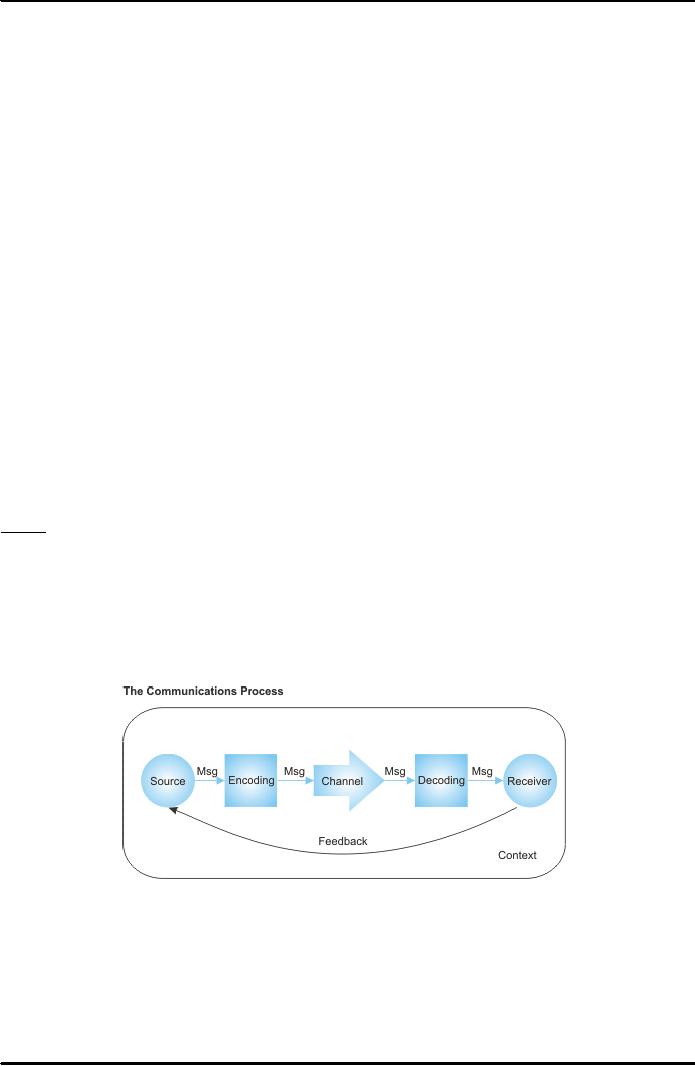 |

Project
Management MGMT627
VU
LESSON
43
COMMUNICATION
IN THE PROJECT
MANAGEMENT
BROAD
CONTENTS
Communication
Interpersonal
Communication
Barriers
in Interpersonal Communication and
Importance of Barrier
Removal
Writing
Skills
Letter
Writing
Active
Listening
Presentations
Conducting
Project Meetings
43.1
Communication
The
purpose of communication is to get your
message across to others
clearly and unambiguously.
Doing
this involves effort from
both the sender of the
message and the receiver.
And it's a process
that
can
be fraught with error, with
messages often misinterpreted by the
recipient. When this isn't
detected,
it
can cause tremendous
confusion, wasted effort and
missed opportunity. In fact,
communication is
only
successful when both the
sender and the receiver understand the
same information as a result of
the
communication.
By successfully getting your message
across, you convey your
thoughts and ideas
effectively.
When not successful, the
thoughts and ideas that you
send do not necessarily reflect
your
own,
causing a communications breakdown and creating
roadblocks that stand in the
way of your goals
both personally and
professionally.
In
a recent survey of recruiters from
companies with more than
50,000 employees, communication
skills
were
cited as the single more important
decisive factor in choosing managers.
The survey, conducted by
the
University of Pittsburgh's Katz
Business School, points out
that communication skills,
including
written
and oral presentations, as well as an
ability to work with others,
are the main factor
contributing
to
job success.
In
spite of the increasing importance placed on
communication skills, many
individuals continue to
struggle,
unable to communicate their thoughts and
ideas effectively whether in
verbal or written
format.
This inability makes it
nearly impossible for them to
compete effectively in the workplace,
and
stands
in the way of career progression.
Getting
your message across is paramount to
progressing. To do this, you must
understand what your
message
is, what audience you are sending it
to, and how it will be
perceived. You must also
weigh-in
the
circumstances surrounding your
communications, such as situational and
cultural context.
Communication
In the context of Project
Manager
Project
Communication Management provides a
critical link between "people,
ideas, & information" at
all
stages in Project Life
Cycle. Communication in Project
Management is a formal process
aid in
"decision
making" & help to achieve a
successful project. Approximately
70-90% of a typical
Project
Manager's
time is spent in Communication
according to the following
proportion:
�
Approximately
45% - Listening.
�
Another
~30%- Talking.
�
PM's
spend ~ 50% of time in
meetings.
Communication
Management Plan defines how & when
various stakeholder receive
information &
communicate
with each other. Memos,
emails etc. are non-formal
communication types. Total number
of
communication channels between stakeholders is
given by the following
relationship.
N(N
- 1)/2 (where N is the number of
stakeholders)
343

Project
Management MGMT627
VU
It
means that if there are 10
stakeholder in a project, that
project will have 45 channels
of
communication.
Cost
of Correspondence
One
page business letter that
took 10 min to dictate cost
between $13.60 & $20.52 in 1996.
one can
imagine
its cost today. poor
writing costs even more since it
wastes time, wastes effort
and jeopardizes
goodwill.
Characteristics
of Effective Communication
Following
are some of the characteristics of
effective communication.
�
Fostering
an "Open Communication
Climate.
�
Committing
to "Ethical Communication.
�
Understanding"Dynamics
of Intercultural Communication".
�
Becoming
Proficient in Communication
Technology.
�
Using
an "Audience Centered Approach".
�
Creating
& Processing Messages
Efficiently".
In
series of transmission form one person to
next, message becomes less
& less accurate. Poor
retention
of
information is another serious problem.
It necessitates repeating message &
using several channels. It
will
obviously require use more
than one channel to Communication same
message.
Figure
43.1: Percentage of Understanding Lost in
Communication
Figure
43.2: Information Loss in
Downward Communication
344

Project
Management MGMT627
VU
Techniques
to Improve Organization
Communication
Following
are some of the techniques, or process
improvements that can
improve the communication in
any
organization.
�
Emphasis
on Teamwork
�
Improve
Reporting System
�
Focus
on Employees Participation &
Involvement
�
Improve
Management System
�
Change
Organizational Culture
�
Flatter
Hierarchy
�
Cross
Functional Teams
�
Fewer
Control
The
function of communication is to provide
form in which ideas &
purposes can be expressed
as
Message.
Vocabulary, language, & knowledge
play important role in
sender's ability to
encode.
43.2
Interpersonal
Communication
Interpersonal
communication is the process of sending and
receiving information between two or
more
people.
Communication is interpersonal when the
people involved are
contacting each other as
persons,
on
a personal level.
Effective
Communication is much more than
simply transmitting information to
employees. It requires
face-to-face
contact in environment of "Openness &
Trust". Several aspects of
Interpersonal
communication
include Talking, Listening,
Reading, Writing and the more
formalized aspects such
as
conducting
meetings, interviews etc. and so
on.
Elements
of Good Talking
�
Voice
Quality
�
Talking
Style
�
Word
Choice and Vocabulary
Three
Broad Types of Interpersonal
Communication:
�
Oral
�
Written
�
Nonverbal
Oral
Communication consists
of all forms of spoken Information &
Most preferred type
of
Communication
used by Managers. Managers
prefer face-to-face & Tele
Communication to written
Communication
because it permits immediate
feedback.
Written
Communication Letters,
memos, policy manuals, reports,
forms, & other documents
are used
to
share Information in
Organization.
Types
of Nonverbal Communication
�
Body
Language
�
Space
�
Time
�
Para
language
�
Color
�
Layout
and Design
43.3
Barriers
against Effective Interpersonal
Communication
Emotions
Sometimes when people communicate an
idea or matter across, the receiver
can feel how the
sender
perceives the subject matter. Often
messages are interpreted
differently for different
people.
Extreme
emotions are most likely to
hinder effective communication
because the idea or
message
345

Project
Management MGMT627
VU
maybe
misinterpreted. It's always
best to avoid responding or
reacting to the subject matter when
you're
upset
or angry because most of the
time, you'll not be able to
think in a clear manner.
Filtering
This
is where the sender manipulates the
information that he communicates to the
receiver.
The
purpose of this is because
sometimes people would shape
and reform the message so that it
appears
and
sounds favorable to the
receiver. Filtering information
may mislead the receiver into
thinking into
something
favorable and the let down
may be upsetting if it's
found out that information
has been
filtered.
Overloaded
with Information Too
much information about the
same subject matter may be
confusing.
For
example, you have 50 e-mails on the
same subject matter, each
e-mail contains a little part of
the
subject
matter. It would be better to have one
e-mail from the sender which
includes all the
information
in
clear and simple form with
only the information you
want that you asked
for. Normally, the human
brain
can only take in so much
information to process, overloading it
with information will exceed
our
human
processing capacity, and the receiver
would often misunderstand or not
understand at all what
the
sender is telling them.
Defensiveness
Humans
tend to refuse for a mutual
understanding when they feel
that they are
being
threatened
or are put in a position
which they are at a disadvantage.
Defensiveness normally consists
of
attacking
what the sender tells you,
putting out sarcastic remarks,
questioning their motives or
being
overly
judgmental about the subject
matter.
Cultural
Difference Sometimes
our culture may be a huge
hindrance for effective
interpersonal
communication.
When two people with
different cultures communicate, they
often do not understand
each
other's cultures and may misunderstand the
true meaning of what each
other's trying to
convey
through
such a sense. For example,
Japanese people would say
'ha-i' and Americans may
misunderstand
that
they are saying "hi".
This makes the intentions unclear between
both people.
Jargon
Not everyone understands
each other's jargon words.
Jargon should be avoided when
talking to
someone
who isn't familiar with
you personally or within
your organization.
43.3.1
The importance of removing
barriers
Problems
with communication can
pop-up at every stage of the
communication process (which
consists
of
sender,
encoding,
channel,
decoding,
receiver,
feedback
and
context
-
see the diagram below)
and
have
the
potential
to
create
misunderstanding
and
confusion.
Figure
43.3: The Communication
Process
To
be an effective communicator and to get
your point across without
misunderstanding and confusion,
your
goal should be to lessen the
frequency of these problems at each
stage of this process with
clear,
concise,
accurate, well-planned communications. We
follow the process through
below:
346

Project
Management MGMT627
VU
SOURCE
As
the source of the message, you
need to be clear about why
you're communicating, and what
you want
to
communicate. You also need to be
confident that the information
you're communicating is useful
and
accurate.
MESSAGE
The
message is the information that
you want to communicate.
ENCODING
This
is the process of transferring the
information you want to communicate
into a form that can be
sent
and
correctly decoded at the other end.
Your success in encoding
depends partly on your
ability to
convey
information clearly and simply,
but also on your ability to
anticipate and eliminate sources
of
confusion
(for example, cultural
issues, mistaken assumptions, and missing
information.) A key part
of
this
is knowing your audience: Failure to
understand who you are
communicating with will
result in
delivering
messages that are
misunderstood.
CHANNEL
Messages
are conveyed through
channels, with verbal
including face-to-face meetings, telephone
and
videoconferencing;
and written including letters, emails,
memos and reports.
Different
channels have different strengths and
weaknesses. For example,
it's not particularly
effective
to
give a long list of
directions verbally, while
you'll quickly cause problems if
you criticize someone
strongly
by email.
DECODING
Just
as successful encoding is a skill, so is
successful decoding (involving,
for example, taking the
time
to
read a message carefully, or
listen actively to it.) Just
as confusion can arise from
errors in encoding,
it
can also arise from
decoding errors. This is particularly the
case if the decoder doesn't have
enough
knowledge
to understand the message.
RECEIVER
Your
message is delivered to individual
members of your audience. No doubt,
you have in mind the
actions
or reactions you hope your message
will get from this audience.
Keep in mind, though, that
each
of
these individuals enters
into the communication process
with ideas and feelings that
will undoubtedly
influence
their understanding of your
message, and their response. To be a
successful communicator,
you
should consider these before
delivering your message, and
act appropriately.
FEEDBACK
Your
audience will provide you
with feedback, verbal and nonverbal
reactions to your communicated
message.
Pay close attention to this
feedback as it is the only thing that
allows you to be confident
that
your
audience has understood your message. If
you find that there has
been a misunderstanding, at least
you
have the opportunity to send the message
a second time.
CONTEXT
The
situation in which your
message is delivered is the context.
This may include the
surrounding
environment
or broader culture (i.e. corporate
culture, international cultures,
etc.).
WRITING
SKILLS
43.4
Many
people are intimidated by
writing. Even so, there are
times when writing is the best
way to
communicate,
and often the only way to get
your message across.
Write
With Necessary
Caution
When
writing, remember that once
something is in written form, it cannot be
taken back.
Communicating
this way is concrete than
verbal communications, with less
room for error and even
less
347

Project
Management MGMT627
VU
room
for mistakes. This presents
written communicators with additional
challenges, including spelling,
grammar,
punctuation, even writing style and
actual wording.
Thankfully,
today's technology makes
memo, letter and proposal
writing much easier by
providing
reliable
tools that check and even
correct misspelled words and incorrect grammar
use. Unfortunately,
these
tools are not foolproof and
will require your support,
making your knowledge in
this area
important.
The
Importance of "Style"
Some
of the most basic tips to
remember when writing
include:
�
Avoid
slang words
�
Try
not to use abbreviations
(unless appropriately
defined)
�
Steer
away from the symbols (such as
ampersands [&])
�
Clich�s
should be avoided, or at the very
least, used with
caution
�
Brackets
are used to play down words
or phrases
�
Dashes
are generally used for
emphasis
�
Great
care should ALWAYS be taken to
spell the names of people and
companies correctly
�
Numbers
should be expressed as words when the
number is less than 10 or is used to
start a
sentence
(example: Ten years ago, my
brother and I...). The number 10, or
anything greater than
10,
should be expressed as a figure
(example: My brother has 13
Matchbox cars.)
�
Quotation
marks should be placed around
any directly quoted speech
or text and around titles
of
publications
�
Keep
sentences short
While
these tips cover the most
common mistakes made when
writing letters, memos and reports,
they
in
no way cover everything you
need to know to ensure your
written communications are
accurate
and
understood.
While
this takes some practice, there
are many sources available
to assist with writing
style, including
"The
Elements of Style", by Strunk and
White. One glance in any newsroom or on
the desk of even the
most
accomplished writers and you
are sure to find this
small, easy-to-understand, no-nonsense
guide to
writing.
It is clear, concise and perhaps the
best book of its kind. If
you plan on writing a great
deal of
letters
or even proposals, it is strongly recommended
that you pick up this
nifty guide, which by
the
way,
will fit in your shirt
pocket.
43.5
Letter
Writing
When
writing letters, it is best to address
the letter to an individual. And,
when beginning the letter
with
a
personal name, be sure to end it with an
appropriate closing, such as
`Sincerely yours'. If you
cannot
obtain
an individual's name, consider ending it
with a more generic (less personal)
closing, such as
`With
kindest regards'.
For
normal business letters, your
letter should start with an
overall summary, showing in the
first
paragraph
why the letter is relevant to the reader.
It's not a good practice to
make the reader go past
the
first
paragraph to find out why the
letter was sent to
them.
The
body of the letter needs to
explain the reason for the
correspondence, including any
relevant
background
and current information. Make
sure the information flows
logically, ensuring you
are
making
your points
effectively.
The
closing of the letter is the final
impression you leave with the reader.
End with an action point,
such
as
`I will call you later
this week to discuss this
further'.
The
Importance of Careful Proofing
Perhaps
the most important thing to
remember when writing a
letter is to check it thoroughly
when it is
completed.
Even when you think it is
exactly what you want,
read it one more time. This
"unwritten"
rule
holds true for everything
you write memos, letters,
proposals, etc.
Use
both the grammar and spell check on
your computer, paying very,
very close attention to
every
word
highlighted. Do not place total
faith on your computer here.
Instead, you should have
both a
dictionary
and thesaurus (printed or
online) to hand to double-check
everything your computer's
editing
tools
highlight, as these tools
are certainly not always
reliable, for a variety of
reasons.
348

Project
Management MGMT627
VU
When
checking your written communications,
make sure the document is clear and concise. Is
there
anything
in the written communication that
could be misinterpreted? Does it
raise unanswered questions
or
fail to make the point you
need to get across?
Can
you cut down on the number of words used?
For instance, don't use 20 words
when you can use
10.
While
you do not want to be curt
or abrupt, you do not want
to waste the reader's time with
unnecessary
words
or phrases.
Is
your written communication
well organized? Does each
idea proceed logically to the
next? Would
some
additional headings help? Make
sure your written communications
are easy to read and
contain
the
necessary information, using
facts where needed and avoiding
information that is not
relevant.
Again,
outline the course of action
you expect, such as a return
call or visit.
Close
appropriately, making sure to
include your contact information.
While this may seem
obvious, it
is
sometimes overlooked and can make
your written communications look
amateurish. This can
diminish
your chances of meeting your
written communication's goals.
43.6
Active
Listening
It
is obvious to say that if
you have poor interpersonal
communications skills (which include
active
listening),
your productivity will
suffer simply because you do
not have the tools needed to
influence,
persuade
and negotiate all necessary
for workplace success. Lines
of communications must be open
between
people who rely on one another to get
work done.
Considering
this, you must be able to
listen attentively if you
are to perform to expectations,
avoid
conflicts
and misunderstandings, and to succeed - in any
arena. Following are a few
short tips to help
you
enhance your communications skills and to
ensure you are an active
listener:
1.
Start by Understanding Your Own
Communication Style
Good
communication skills require a
high level of self-awareness.
Understanding your personal style
of
communicating
will go a long way toward
helping you to create good
and lasting impressions on others.
By
becoming more aware of how
others perceive you, you
can adapt more readily to their styles
of
communicating.
This does not mean
you have to be a chameleon, changing with
every personality you
meet.
Instead, you can make
another person more comfortable with
you by selecting and emphasizing
certain
behaviors that fit within
your personality and
resonate with another. In
doing this, you
will
prepare
yourself to become an active
listener.
2.
Be an Active Listener
People
speak at 100 to 175 words per
minute (WPM), but they
can listen intelligently at up to
300 words
per
minute. Since only a part of
our mind is paying
attention, it is easy to go into
mind drift - thinking
about
other things while listening
to someone. The cure for
this is active listening -
which involves
listening
with a purpose. It may be to gain
information, obtain directions,
understand others, solve
problems,
share interest, see how another
person feels, show support, etc.
If
you're finding it particularly
difficult to concentrate on what
someone is saying, try
repeating their
words
mentally as they say it -
this will reinforce their
message and help you control
mind drift.
3.
Use Nonverbal Communication
Use
nonverbal behaviors to raise the channel
of interpersonal communication.
Nonverbal
communication
is facial expressions like
smiles, gestures, eye contact, and even
your posture. This
shows
the person you are
communicating with that you
are indeed listening
actively and will
prompt
further
communications while keeping costly,
time-consuming misunderstandings at a
minimum.
4.
Give Feedback
Remember
that what someone says
and what we hear can be
amazingly different! Our personal
filters,
assumptions,
judgments, and beliefs can distort
what we hear. Repeat back or
summarize to ensure
that
you
understand. Restate what you
think you heard and ask,
"Have I understood you correctly?" If
you
find
yourself responding emotionally to
what someone said, say so,
and ask for more information:
"I
may
not understand you correctly,
and I find myself taking
what you said personally.
What I thought
you
just said is XXX; is that
what you meant?"
349

Project
Management MGMT627
VU
Feedback
is a verbal communications means used to
clearly demonstrate you are
actively listening
and
to
confirm the communications between you and
others. Obviously, this
serves to further ensure
the
communications
are understood and is a great tool to use
to verify everything you heard
while actively
listening.
43.7
Presentation
Planning Checklist
This
presentation checklist will help
you deliver successful presentation.
This is adapted in part
from
"Business
Communications: A Cultural and Strategic
Approach" by Michael J. Rouse
and Sandra
Rouse.
Presentation:
Does
your introduction grab
participant's attention and explain
your objectives?
Do
you follow this by clearly
defining the points of the
presentation?
Are
these main points in logical
sequence?
Do
these flow well?
Do
the main points need support
from visual aids?
Does
your closing summarize the presentation
clearly and concisely?
Is
the conclusion strong?
Have
your tied the conclusion to the
introduction?
Delivery:
Are
you knowledgeable about the
topic covered in your
presentation?
Do
you have your notes in
order?
Where
and how will you present
(indoors, outdoors, standing,
sitting, etc.)?
Have
you visited the presentation
site?
Have
you checked your visual
aids to ensure they are
working and you know how to
use them?
Appearance:
Make
sure you are dressed
and groomed appropriately and in keeping
with the audience's expectations.
Practice
your speech standing (or
sitting, if applicable), paying
close attention to your body
language,
even
your posture, both of which
will be assessed by the audience.
Visual
Aids:
Are
the visual aids easy to read
and easy to
understand?
Are
they tied into the points
you are trying to
communicate?
Can
they be easily seen from
all areas of the room?
Running
Effective Project
Meetings
43.8
Meetings
are wonderful tools for
generating ideas, expanding on
thoughts and managing group
activity.
But
this face-to-face contact with team
members and colleagues can easily
fail without adequate
preparation
and leadership.
The
Importance of Preparation
To
ensure everyone involved has
the opportunity to provide their
input, start your meeting
off on the
right
foot by designating a meeting
time that allows all
participants the time needed to
adequately
prepare.
Once
a meeting time and place has
been chosen, make yourself
available for questions that
may arise as
participants
prepare for the meeting. If
you are the meeting leader,
make a meeting agenda,
complete
with
detailed notes.
350

Project
Management MGMT627
VU
Managing
a Meeting
Choosing
the right participants is key to the
success of any meeting. Make
sure all participants
can
contribute
and choose good decision-makers and
problem-solvers. Try to keep the number
of
participants
to a maximum of 12, preferably
fewer. Make sure the people
with the necessary
information
for
the items listed in the meeting agenda
are the ones that are
invited.
When
an agenda item is resolved or
action is agreed upon, make
it clear who in the meeting will
be
responsible
for this. In an effort to
bypass confusion and misunderstandings,
summarize the action to be
taken
and include this in the meeting's
minutes.
Time
Keeping
Meetings
are notorious for eating up
people's time. Here are
some ways of ensuring that
time is not
wasted
in meetings:
�
Start on
time.
�
Don't
recap what you've covered if
someone comes in late: doing
so sends the message that it is
OK
to
be late for meetings, and it wastes
everyone else's valuable
time.
�
State
a finish time for the
meeting and don't
over-run.
�
To
help stick to the stated
finish time, arrange your
agenda in order of importance so
that if you
have
to omit or rush items at the end to make
the finish time, you
don't omit or skimp on
important
items.
�
Finish
the meeting before the stated
finish time if you have achieved
everything you need
to.
Issuing
Minutes
Minutes
record the decisions of the meeting and the actions
agreed. They provide a record of
the
meeting
and, importantly, they provide a
review document for use at the
next meeting so that
progress
can
be measured - this makes them a
useful disciplining technique as
individuals' performance and non-
performance
of agreed actions is given high
visibility.
351
Table of Contents:
- INTRODUCTION TO PROJECT MANAGEMENT:Broad Contents, Functions of Management
- CONCEPTS, DEFINITIONS AND NATURE OF PROJECTS:Why Projects are initiated?, Project Participants
- CONCEPTS OF PROJECT MANAGEMENT:THE PROJECT MANAGEMENT SYSTEM, Managerial Skills
- PROJECT MANAGEMENT METHODOLOGIES AND ORGANIZATIONAL STRUCTURES:Systems, Programs, and Projects
- PROJECT LIFE CYCLES:Conceptual Phase, Implementation Phase, Engineering Project
- THE PROJECT MANAGER:Team Building Skills, Conflict Resolution Skills, Organizing
- THE PROJECT MANAGER (CONTD.):Project Champions, Project Authority Breakdown
- PROJECT CONCEPTION AND PROJECT FEASIBILITY:Feasibility Analysis
- PROJECT FEASIBILITY (CONTD.):Scope of Feasibility Analysis, Project Impacts
- PROJECT FEASIBILITY (CONTD.):Operations and Production, Sales and Marketing
- PROJECT SELECTION:Modeling, The Operating Necessity, The Competitive Necessity
- PROJECT SELECTION (CONTD.):Payback Period, Internal Rate of Return (IRR)
- PROJECT PROPOSAL:Preparation for Future Proposal, Proposal Effort
- PROJECT PROPOSAL (CONTD.):Background on the Opportunity, Costs, Resources Required
- PROJECT PLANNING:Planning of Execution, Operations, Installation and Use
- PROJECT PLANNING (CONTD.):Outside Clients, Quality Control Planning
- PROJECT PLANNING (CONTD.):Elements of a Project Plan, Potential Problems
- PROJECT PLANNING (CONTD.):Sorting Out Project, Project Mission, Categories of Planning
- PROJECT PLANNING (CONTD.):Identifying Strategic Project Variables, Competitive Resources
- PROJECT PLANNING (CONTD.):Responsibilities of Key Players, Line manager will define
- PROJECT PLANNING (CONTD.):The Statement of Work (Sow)
- WORK BREAKDOWN STRUCTURE:Characteristics of Work Package
- WORK BREAKDOWN STRUCTURE:Why Do Plans Fail?
- SCHEDULES AND CHARTS:Master Production Scheduling, Program Plan
- TOTAL PROJECT PLANNING:Management Control, Project Fast-Tracking
- PROJECT SCOPE MANAGEMENT:Why is Scope Important?, Scope Management Plan
- PROJECT SCOPE MANAGEMENT:Project Scope Definition, Scope Change Control
- NETWORK SCHEDULING TECHNIQUES:Historical Evolution of Networks, Dummy Activities
- NETWORK SCHEDULING TECHNIQUES:Slack Time Calculation, Network Re-planning
- NETWORK SCHEDULING TECHNIQUES:Total PERT/CPM Planning, PERT/CPM Problem Areas
- PRICING AND ESTIMATION:GLOBAL PRICING STRATEGIES, TYPES OF ESTIMATES
- PRICING AND ESTIMATION (CONTD.):LABOR DISTRIBUTIONS, OVERHEAD RATES
- PRICING AND ESTIMATION (CONTD.):MATERIALS/SUPPORT COSTS, PRICING OUT THE WORK
- QUALITY IN PROJECT MANAGEMENT:Value-Based Perspective, Customer-Driven Quality
- QUALITY IN PROJECT MANAGEMENT (CONTD.):Total Quality Management
- PRINCIPLES OF TOTAL QUALITY:EMPOWERMENT, COST OF QUALITY
- CUSTOMER FOCUSED PROJECT MANAGEMENT:Threshold Attributes
- QUALITY IMPROVEMENT TOOLS:Data Tables, Identify the problem, Random method
- PROJECT EFFECTIVENESS THROUGH ENHANCED PRODUCTIVITY:Messages of Productivity, Productivity Improvement
- COST MANAGEMENT AND CONTROL IN PROJECTS:Project benefits, Understanding Control
- COST MANAGEMENT AND CONTROL IN PROJECTS:Variance, Depreciation
- PROJECT MANAGEMENT THROUGH LEADERSHIP:The Tasks of Leadership, The Job of a Leader
- COMMUNICATION IN THE PROJECT MANAGEMENT:Cost of Correspondence, CHANNEL
- PROJECT RISK MANAGEMENT:Components of Risk, Categories of Risk, Risk Planning
- PROJECT PROCUREMENT, CONTRACT MANAGEMENT, AND ETHICS IN PROJECT MANAGEMENT:Procurement Cycles